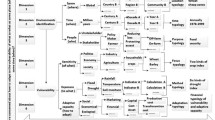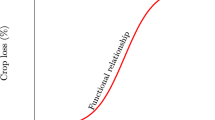Abstract
In this paper, we evaluate a single-index polymorphic production function that relates agricultural output to temperature and precipitation. The advantage of this new approach to measuring agricultural vulnerability under climatic change is that a single-index measure of vulnerability can capture a range of climate responses including plateau effects. The approach identifies plateau effects in the crop yield-weather relationship and provides overall fits consistent with higher-order polynomial fitting. We apply the technique to corn, soybeans, wheat, and cotton at the USA county level. We illustrate its computation and use as a critical policy variable.









Similar content being viewed by others
Availability of data and material
Publicly available.
Code availability
Code and data necessary to fully reproduce the results of this study are housed at a permanent repository at the Cornell Institute for Social and Economic Research: [DOI Link TBD].
Notes
Because of logarithmic scaling, however, values close to 1 or −1 tend to be highly unstable so we limited the range to fall between −0.99 and 0.99.
Holling (1973) was referring to bifurcations in natural ecosystems leading to new stable equilibria after a period of adaptation. The agricultural response to climate change discussed in this paper leads to new equilibria but by man’s design. Gunderson (1999) was considering issues in resource management in which the human desire is to catch a potentially irreversible phase transition and reverse engineer the process to its initial state or equilibrium.
This includes empirical measurement of sustainability, vulnerability, and resilience. Lestari and Pigawati’s (2018) approach to climate vulnerability uses a traditional mathematical formulation based on the IPCC framework. Vulnerability is the sum score of exposure (probability), sensitivity, and adaptive capacity measured at the village level. Reilly et al. (2003). They approach the climate change effect on three major crops (Maize, Wheat, and Potato) in the USA by analyzing the trends in yield variability. Jayathilaka et al. (2012) approach crop/climate sensitivity mapping by spatial assessment. They connect the dynamics of the climate indicator and major crop yield in a geo-referred map by using the levels of crop vulnerability classes including precipitation, relative humidity, temperature, evapotranspiration, and yield class for each crop. Nonlinear models proposed by Schlenker and Roberts (2009) include the step function, eighth-order polynomial function, and piecewise linear specification. However, they analyze and evaluate the nonlinear temperature and yield relationship on a large (national) scale which makes it difficult from a policy perspective to identify regional “hot spots” of vulnerability. Nonetheless, as we have previously cited, their crop response functions, and in particular their cotton response function, suggest significant plateaus that are very consistent with what our vulnerability index aims to capture. Ortiz-Bobea et al. (2019) estimate the climate change effect on the different periods of the growing season for different types of crops based on county level data and also the contribution of different climate drivers on the crop yield. Simelton et al. (2009) propose the use of the socioeconomic model to solve crop vs. climate change vulnerability index when facing the contradictions between significant yield losses with minor drought and minor yield losses This tranche of research is in line with the broader paradigm on sustainability offered in Turner et al. (2003) who focus attention on the coupled human-environment systems of which sustainability and vulnerability are predicated on the synergies between human and biophysical subsystems.
Our selection of 0.5 is somewhat arbitrary but worked quite well against alternative measures.
References
Bucheli J, Dalhaus T, Finger R (2020) The optimal drought index for designing weather index insurance. Eur Rev Agric Econ, jbaa014. https://doi.org/10.1093/erae/jbaa014
Calvo C, Dercon S (2005) “Measuring Individual Vulnerability.” Discussion Paper Series.#229, Department of Economics, Oxford University
Carlson JL, Haffenden RA, Bassett GW, Buehring WA, Collins MJ III, Folga SM et al (2012) Resilience: theory and application (No. ANL/DIS-12-1). Argonne National Lab (ANL), Argonne, IL (United States)
D’Agostino AL, Schlenker W (2016) Recent weather fluctuations and agricultural yields: implications for climate change. Agric Econ 47(S1):159–171
d’Errico M, Romano D, Pietrelli R (2018) Household resilience to food insecurity: evidence from Tanzania and Uganda. Food Security 10(4):1033–1054
Edwards JH (2015) The structure of disaster resilience: a framework for simulations and policy recommendations. Nat Hazards Earth Syst Sci 15(4):827–841
Gunderson L (1999) Resilience, flexibility and adaptive management – antidotes for spurious certitude? Conserv Ecol 3(1)
Haqiqi I, Grogan DS, Hertel TW, Schlenker W (2021) Quantifying the impacts of compound extremes on agriculture. Hydrol Earth Syst Sci 25(2):551–564
Holling CS (1973) Resilience and stability of ecological systems. Annu Rev Ecol Syst 4(1):1–23
Holling CS, Gunderson LH, Peterson GD (2002) Sustainability and panarchies. In: Holling CS, Gunderson LH (eds) Panarchy: understanding transformations in human and natural systems, 63-102. Island Press
Jayathilaka PMS, Soni P, Perret SR, Jayasuriya HPW, Salokhe VM (2012) Spatial assessment of climate change effects on crop suitability for major plantation crops in Sri Lanka. Reg Environ Chang 12(1):55–68
Kontokosta CE, Malik A (2018) The resilience to emergencies and disasters index: applying big data to benchmark and validate neighborhood resilience capacity. Sustain Cities Soc 36:272–285
Lestari DR, Pigawati B (2018) Drought disaster vulnerability mapping of agricultural sector in Bringin District, Semarang Regency. IOP Conference Series: Earth and Environmental Science 123:012031
Lobell DB, Burke MB, Tebaldi C, Mastrandrea MD, Falcon WP, Naylor RL (2008) Prioritizing climate change adaptation needs for food security in 2030. Science 319(5863):607–610
Meuwissen MP, Feindt PH, Spiegel A, Termeer CJ, Mathijs E, de Mey Y et al (2019) A framework to assess the resilience of farming systems. Agric Syst 176:102656
Ortiz-Bobea A, Knippenberg E, Chambers RG (2018) Growing climatic sensitivity of US agriculture linked to technological change and regional specialization. Sci Adv 4(12):eaat4343
Ortiz-Bobea A, Wang H, Carrillo CM, Ault TR (2019) Unpacking the climatic drivers of US agricultural yields. Environmental Research Letters 14(6):064003
Ortiz-Bobea A, Ault TR, Carrillo CM, Chambers RG, Lobell DB (2020) The historical impact of anthropogenic climate change on global agricultural productivity. arXiv preprintarXiv:2007:10415
Porter JR, Semenov MA (2005) Crop responses to climatic variation. Philosophical Transactions of the Royal Society B: Biological Sciences 360(1463):2021–2035
“PRISM Climate Group, Oregon State U”. (n.d.). , available at: http://www.prism.oregonstate.edu/ (accessed 5 May 2020)
Reilly J, Tubiello F, McCarl B, Abler D, Darwin R, Fuglie K, Hollinger S et al (2003) U.S. Agriculture and climate change: new results. Clim Chang 57(1/2):43–67
Schlenker W, Roberts MJ (2009) Nonlinear temperature effects indicate severe damages to U.S. crop yields under climate change. Proc Natl Acad Sci 106(37):15594–15598
Seneviratne SI, Corti T, Davin EL, Hirschi M, Jaeger EB, Lehner I et al (2010) Investigating soil moisture-climate interactions in a changing climate: a review. Earth Sci Rev 99(3-4):125–161
Simelton E, Fraser EDG, Termansen M, Forster PM, Dougill AJ (2009) Typologies of crop-drought vulnerability: an empirical analysis of the socio-economic factors that influence the sensitivity and resilience to drought of three major food crops in China (1961-2001). Environ Sci Pol 12(4):438–452
Smith LC, Frankenberger TR (2018) Does resilience capacity reduce the negative impact of shocks on household food security? Evidence from the 2014 floods in Northern Bangladesh. World Dev 102:358–376
Tack J, Barkley A, Nalley LL (2015) Effect of warming temperatures on US wheat yields. Proc Natl Acad Sci 112(22):6931–6936
Tack J, Lingenfelser J, Jagadish SK (2017) Disaggregating sorghum yield reductions under warming scenarios exposes narrow genetic diversity in US breeding programs. Proc Natl Acad Sci 114(35):9296–9301
Tian L, Yuan S, Quiring SM (2018) Evaluation of six indices for monitoring agricultural drought in the south-central United States. Agric For Meteorol 249:107–119
Turner BL, Kasperson RE, Matson PA, McCarthy JJ, Corell RW, Christensen L et al (2003) A framework for vulnerability analysis in sustainability science. Proc Natl Acad Sci 100(14):8074–8079
Turvey CG, Shee A, Marr A (2019) Addressing fractional dimensionality in the application of weather index insurance and climate risk financing in agricultural development: a dynamic triggering approach. Weather, Climate and Society 11(4):901–915
USDA ERS - Drought-Tolerant Corn in the United States: Research, Commercialization, and Related Crop Production Practices (n.d.-a). Available at: https://www.ers.usda.gov/amber-waves/2019/march/drought-tolerant-corn-in-the-united-states-research-commercialization-and-related-crop-production-practices/. Accessed 5 May 2020.
USDA ERS - Drought-Tolerant Corn in the United States: Research, Commercialization, and Related Crop Production Practices (n.d.-b). Available at: https://www.ers.usda.gov/amber-waves/2019/march/drought-tolerant-corn-in-the-united-states-research-commercialization-and-related-crop-production-practices/. Accessed 5 May 2020.
USDA ERS - Irrigation & Water Use (n.d.-c). Available at: https://www.ers.usda.gov/topics/farm-practices-management/irrigation-water-use/. Accessed 5 May 2020).
USDA/NASS QuickStats Ad-hoc Query Tool. Available at: https://quickstats.nass.usda.gov/. Accessed 5 May 2020.
Author information
Authors and Affiliations
Contributions
Calum G. Turvey developed the central ideas and conceptual/analytical framework to this paper and prepared the final manuscript. Jiajun Du contributed the analytical framework including all initial statistics, coding, mapping, and figures as part of his MS thesis at Cornell University. Ariel Ortiz-Bobea contributed materially to the conceptual and analytical framework including development of R code, mapping, and design of direct and robustness tests. Yurou He ensured the reproducibility of the project and polished the code and figures in the paper. All authors contributed to the drafting of this manuscript.
Corresponding author
Ethics declarations
Ethical approval
Not applicable.
Consent to participate
Not applicable.
Consent to publish
Not applicable.
Conflict of interest
Not applicable.
Additional information
Publisher’s note
Springer Nature remains neutral with regard to jurisdictional claims in published maps and institutional affiliations.
Rights and permissions
About this article
Cite this article
Turvey, C.G., Du, J., He, Y. et al. A vulnerability index for priority targeting of agricultural crops under a changing climate. Climatic Change 166, 34 (2021). https://doi.org/10.1007/s10584-021-03135-8
Received:
Accepted:
Published:
DOI: https://doi.org/10.1007/s10584-021-03135-8




